Trail Safety for Carriage Drivers
General Recommendations
Road Safety
You must respect signs and other users when you are on roads. Please:
- Observe all traffic directions
- Ride on the correct side of the road
- Stop at stop signs
- Signal turns or stop if there is someone behind you
- Carry a light visible at least 200 ft to front and rear
- Wear reflective clothing
Trail etiquette
On the trail, courtesy is a necessity.
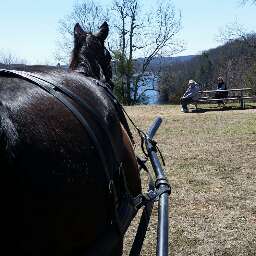
If you drive a horse, you have priority but should observe caution because not all trail users will be aware of this.
The more we strive to apply common sense rules of courtesy and etiquette, the better the chances of a safe and stress-free drive.
In case of problems with other users, always stay polite even if you were not wrong.
About horses1
Before going on the trail, be sure that your horse(s) will be safe for carriage driving:
- Train him/her to stand quietly and relaxed.
- Check he/she is comfortable with other horses whether they are in front of him/her or coming up from behind.
- Do the same with bicycles. They usually come from behind silently and can surprise horses with blinders on.
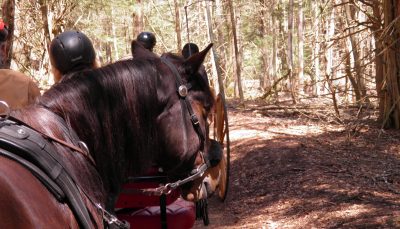
Equipment1,2
- The vehicle and harness should be suitable for the horse(s) and for the type of terrain to be covered.
- Double check your tack, adjustments and attachments to the vehicle before you head out.
- Always have a suitable whip in your hand while driving. It must be capable of reaching the horse’s shoulder.
- Always wear a helmet. Insist your passengers and grooms wear helmets too!
- Carry a halter, a lead shank and a knife with you. Don’t forget your cell phone.
Safety around the carriage1,2,4
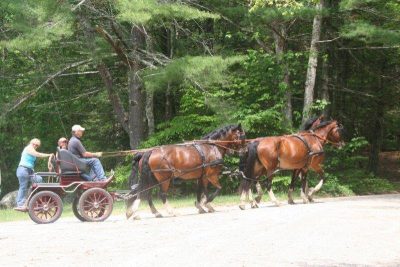
- Never attempt to hold two horses at the same time that are hooked to vehicles except in an emergency.
- Don’t remove the bridle while your horse is still hooked to a vehicle.
- Never leave a horse unattended while he is put to a vehicle.
- Never tie a horse to a fixed object (wall, trailer, hitch post) while it is put to a vehicle.
- Never tie a turnout to another turnout, or tie another horse to a turnout.
- Always leave at least one turnout’s length between turnouts.
When you are driving2,4
- The driver must be the first person in the vehicle and the last one out. Do not leave a passenger in the vehicle
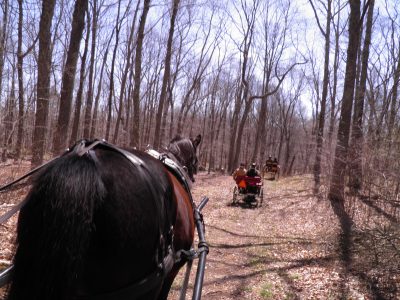 unless he is capable taking control of the reins.
unless he is capable taking control of the reins. - Except for minor adjustments and unhitching, do not get out of your vehicle once the horse is put to. A loose horse with a vehicle attached is very dangerous.
- Sit on the bight end of the reins or use the finger loop.
- Pass another carriage only when you can sufficiently see the trail in front of you.
- Be watchful of your horse(s), especially his ears, which may give warning of his alarm at something he has seen or heard. If something could scare your horse, distract him with a calmly touch of the whip.
- When approaching another horse, stay to the right. Be careful of ridden horses. They can be afraid of moving wheels.
Since most other trail users know little about horses, the carriage driver must be calm and able to direct activities clearly, quietly and with respect for the other trail user.
Sight line
You must be able to see clearly ahead of you before go faster. You do not want to accidentally run into other users.
Lighting3
Be sure to have a slow-moving vehicle sign and reflectors on the back of your carriage to be seen by other users. It needs to be visible three feet above the ground when driving on public roads.
Choose trails where you have good visibility. Always bring a flashlight or lantern to hang on your carriage just in case. Most rescues occur when a person did not expect to be out after dark and did not bring a flashlight. To preserve night vision and avoid blinding other users, use a flashlight that has a red light feature when you are in an area with other users.
Bring phone
It is strongly recommended that everyone on the trail is equipped with a mobile phone. Thus, in case of emergency, it is possible to call for help or simply to contact someone if necessary. Do not leave the phone on your horse or on your vehicle, keep it on your person either through a pouch or some sort of fastening. However, you should not rely on that as your only source of help. Leave an itinerary with someone not with you in case your cell phone battery goes dead.
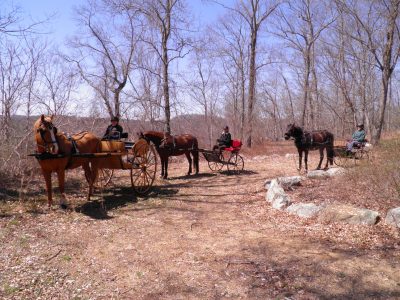
Try to avoid going alone5
Have an active and capable person with you when driving a green horse. Even an experienced driver should, for safety reasons, have help with him when he is driving a young or strange horse. A driver with a pair should always be accompanied by an experienced groom or helper. With four horses, two active and knowledgeable helpers are necessary.
Also, when you leave home, be sure to tell someone when to expect you back and where you might be if you are not back by that time. The sooner someone knows to look for you, the better.

Passing & Special Situations
If your horse is stopped because he is alarmed by something or shows some wariness4
- Avoid whipping the horse.
- Do not allow him to run back.
- If you are on a hill, apply the brakes and have your assistant places a block of wood behind the rear wheel.
- Speak encouragingly and soothingly to him. If needed, have your assistant go to the horse’s head and speak calmly to him.
- If the horse refuses to start, it is better to turn around, go back and find some alternative route.
How to pass an out of control dog4
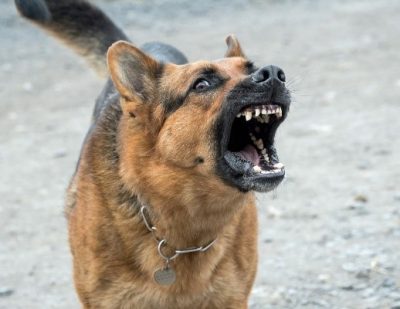
Other people’s dogs can often cause quite serious problems and many people have no control over their dogs whatsoever.
Carriage drivers need to be able to calmly instruct the dog owner on what to do so that dogs and carriages can pass safely.
How to pass bicycles or ATVs3
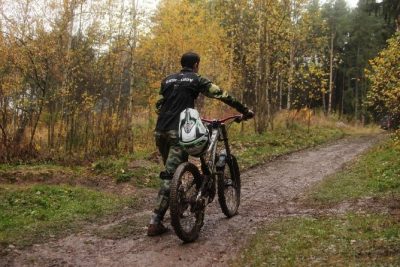
In some locations ATVs and bicycle riders have been “trained” by public multi use trail education campaigns. They have to shut off their engines and/or stop their vehicle and wait quietly until the horse passes. Often, horses are anxious about people and helmets and vehicles. Carriage drivers can talk to vehicle drivers and ask them to speak to their horse and/or take off their helmet.
Manure is biodegradable
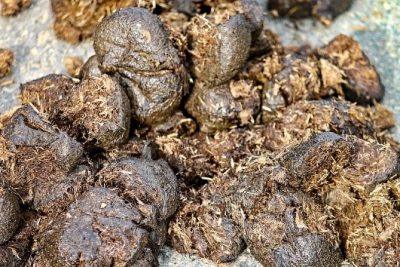
Horse manure is free of micro-organisms that infect humans. Parasites that infect horses are not dangerous to humans. There is no Cryptosporidium or Giardia in horse manure.
Up to 80% of the water in the manure is evaporated or infiltrated in the soil, the rest is undigested parts of plants.
EPA excludes manure from solid waste regulations because it does not contain hazardous chemicals and has no hazardous characteristics.
Bees
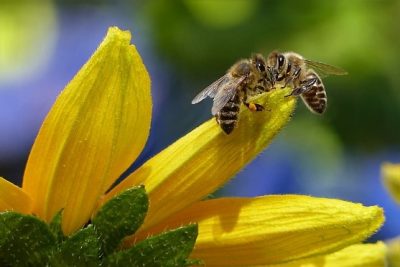
Bees are usually found on the trail from summer to fall with the most dangerous encounters usually from August through September in Connecticut. Bees sting when they feel threatened: it’s their way of defending themselves. During a sting, the sting is usually removed from the bee and remains planted in the skin, causing the death of the bee Unlike bees, wasps can sting without any real reason Their sting is firmly attached to their body, which allows them to sting several times.
To avoid getting bitten, follow these tips:
- Avoid any sudden or rapid movement
- Odors, perfumes and other cosmetics attract insects so avoid using them when you go in the wild
- Keep an eye out for bee activity
Bridge safety
A bridge must be carefully analyzed before asking your horse to cross it. It may be old or obsolete and it can potentially collapse under the weight of the horse and the vehicle.
In addition, horses may be reluctant to cross if the bridge is narrow, swings, vibrates, is built with unknown materials, or amplifies noise.
Contact info
Dr Jenifer Nadeau, Associate Professor, Equine Extension Specialist, University of Connecticut
Camille Guérineau, graduate student and summer intern
camille.guerineau@agrosupdijon.fr
This document was created during the internship of Camille Guérineau from AgroSup Dijon from April to August, 2019 at the University of Connecticut’s Department of Animal Science under the supervision of Dr. Jenifer Nadeau, Equine Extension Specialist and Associate Professor. We would like to sincerely thank the involvement of many of those involved with the CT horse industry who provided input and photos to make this possible as well as Laura Brown, chair of the PATHS Team and Community & Economic Development Educator with Uconn Extension and Certified Economic Developer (CEcD). Also thanks to the other PATHS Team members for their help and support.
We also thank Michelle Lewis, Cynthia Chotkowski, Kristen Govoni, Jen Otis, Peter von Halem, Charlotte Gelston, Anne Zagryn and Steven Mazeau for having contributed to the creation of these web pages by providing us with their photos.
References
Steven Mazeau
1 Jeff Morse, driving instructor / trainer, member of the New England Morgan Horse Association, https://www.greenmeads.com/, consulted 6/18/2019
2 Common accepted safety practices and Accident Prevention for Driving Horses, Iowa Valley Carriage, https://www.ivccarriage.com/, consulted 6/18/2019
3 Carole Hunter
4 Drive smartly…Drive safety, an informational booklet published by the Carriage Association of America
5 EQUUS 356, May 2007,p 77 – 85, Take the trail rider’s Pledge by Gene Wood, PhD, with Laurie Bonner, consulted 05/23/2019
Photography from Pixabay
Videos
https://www.youtube.com/watch?v=vAma6BkGNZ0